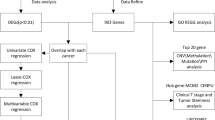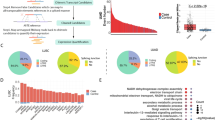Abstract
Long interspersed elements (LINEs or L1 s) are an abundant class of autonomous retrotransposons in the human genome. Full-length L1 elements have two transcriptional regulatory regions: an internal sense promoter and an antisense promoter (ASP). The ASP of L1 elements can generate chimeric RNAs via direct transcription of adjacent genomic sequences. Chimeric transcripts derived from the L1ASP are highly represented, but the extent to which this occurs is largely unknown. Using a genome-wide L1 chimera display (LCD) technique, we have isolated 4 L1 chimeric transcripts (LCTs) in the lung cancer genome. Then, we analyzed the structural characteristics of the 4 LCTs using bioinformatics tool. Expression patterns of the 4 LCTs were analyzed by reverse transcription polymerase chain reaction using normal and lung cancer tissues. LCT24 and LCT25 showed higher expression in lung cancer tissue than in normal tissue. These results suggest that the genome-wide LCD technique could be of great use for further study to find cancer markers via cancer-associated LCTs and to understand cancer biology.



Similar content being viewed by others
References
Ahn K, Gim JA, Ha HS, Han K, Kim HS (2013) The novel MER transposon-derived miRNAs in human genome. Gene 512:422–428
Ashe HL, Monks J, Wijgerde M, Fraser P, Proudfoot NJ (1997) Intergenic transcription and transinduction of the human beta-globin locus. Genes Dev 11:2494–2509
Bolland DJ, Wood AL, Johnston CM, Bunting SF, Morgan G, Chakalova L, Fraser PJ, Corcoran AE (2004) Antisense intergenic transcription in V(D)J recombination. Nat Immunol 5:630–637
Brouha B, Schustak J, Badge RM, Lutz-Prigge S, Farley AH, Moran JV, Kazazian HHJr (2003) Hot L1 s account for the bulk of retrotransposition in the human population. Proc Natl Acad Sci USA 100:5280–5285
Callinan PA, Batzer MA (2006) Retrotransposable elements and human disease. Genome Dyn 1:104–115
Chen HY, Yu SL, Li KC, Yang PC (2012) Biomarkers and transcriptome profiling of lung cancer. Respirology 17:620–626
Cruickshanks HA, Tufarelli C (2009) Isolation of cancer-specific chimeric transcripts induced by hypomethylation of the LINE-1 antisense promoter. Genomics 94:397–406
Dewannieux M, Esnault C, Heidmann T (2003) LINE-mediated retrotransposition of marked Alu sequences. NatGenet 35:41–48
Esnault C, Maestre J, Heidmann T (2000) Human LINE retrotransposons generate processed pseudogenes. Nat Genet 24:363–367
Gribnau J, Diderich K, Pruzina S, Calzolari R, Fraser P (2000) Intergenic transcription and developmental remodeling of chromatin subdomains in the human beta-globin locus. Mol Cell 5:377–386
Hancks DC, Goodier JL, Mandal PK, Cheung LE, Kazazian HHJr (2011) Retrotransposition of marked SVA elements by human L1 s in cultured cells. Hum Mol Genet 20:3386–3400
International Human Genome Sequencing Consortium (2001) Initial sequencing and analysis of the human genome. Nature 409:860–921
Kazazian HHJr (1998) Mobile elements and disease. Curr Opin Genet Dev 8:343–350
Kazazian HHJr (2004) Mobile elements: drivers of genome evolution. Science 303:1626–1632
Lee J, Cordaux R, Han K, Wang J, Hedges DJ, Liang P, Batzer MA (2007) Different evolutionary fates of recently integrated human and chimpanzee LINE-1 retrotransposons. Gene 390:18–27
Lin L, Wang Z, Prescott MS, van Dekken H, Thomas DG, Giordano TJ, Chang AC, Orringer MB, Gruber SB, Moran JV et al (2006) Multiple forms of genetic instability within a 2-Mb chromosomal segment of 3q26.3-q27 are associated with development of esophageal adenocarcinoma. Genes Chromosom Cancer 45:319–331
Maestre J, Tchénio T, Dhellin O, Heidmann T (1995) mRNA retroposition in human cells: processed pseudogene formation. EMBO J 14:6333–6338
Mallardo M, Poltronieri P, D’Urso OF (2008) Non-protein coding RNA biomarkers and differential expression in cancers: a review. J Exp Clin Cancer Res 27:19
Mätlik K, Redik K, Speek M (2006) L1 antisense promoter drives tissue-specific transcription of human genes. J Biomed Biotechnol 2006:71753
Moran JV, Holmes SE, Naas TP, DeBerardinis RJ, Boeke JD, Kazazian HHJr (1996) High frequency retrotransposition in cultured mammalian cells. Cell 87:917–927
Nigumann P, Redik K, Mätlik K, Speek M (2002) Many human genes are transcribed from the antisense promoter of L1 retrotransposon. Genomics 79:628–634
Ocak S, Sos ML, Thomas RK, Massion PP (2009) High-throughput molecular analysis in lung cancer: insights into biology and potential clinical applications. Eur Respir J 34:489–506
Ostertag EM, Kazazian HHJr (2001) Twin priming: a proposed mechanism for the creation of inversions in L1 retrotransposition. Genome Res 11:2059–2065
Proudfoot NJ (1986) Transcriptional interference and termination between duplicated alpha-globin gene constructs suggests a novel mechanism for gene regulation. Nature 322:562–565
Sassaman DM, Dombroski BA, Moran JV, Kimberland ML, Naas TP, DeBerardinis RJ, Gabriel A, Swergold GD, Kazazian HHJr (1997) Many human L1 elements are capable of retrotransposition. Nat Genet 16:37–43
Schmidt LH, Spieker T, Koschmieder S, Schäffers S, Humberg J, Jungen D, Bulk E, Hascher A, Wittmer D, Marra A et al (2011) The long noncoding MALAT-1 RNA indicates a poor prognosis in non-small cell lung cancer and induces migration and tumor growth. J Thorac Oncol 6:1984–1992
Speek M (2001) Antisense promoter of human L1 retrotransposon drives transcription of adjacent cellular genes. Mol Cell Biol 21:1973–1985
Thompson JD, Higgins DG, Gibson TJ (1994) CLUSTAL W: improving the sensitivity of progressive multiple sequence alignment through sequence weighting, position-specific gap penalties and weight matrix choice. Nucleic Acids Res 22:4673–4680
Tufarelli C, Stanley JA, Garrick D, Sharpe JA, Ayyub H, Wood WG, Higgs DR (2003) Transcription of antisense RNA leading to gene silencing and methylation as a novel cause of human genetic disease. Nat Genet 34:157–165
Weber B, Kimhi S, Howard G, Eden A, Lyko F (2010) Demethylation of a LINE-1 antisense promoter in the cMet locus impairs Met signalling through induction of illegitimate transcription. Oncogene 29:5775–5784
Yu W, Gius D, Onyango P, Muldoon-Jacobs K, Karp J, Feinberg AP, Cui H (2008) Epigenetic silencing of tumour suppressor gene p15 by its antisense RNA. Nature 451:202–206
Acknowledgments
The biospecimens for this study were provided by the Pusan National University Hospital, a member of the National Biobank of Korea, which is supported by the Ministry of Health, Welfare and Family Affairs. All samples derived from the National Biobank of Korea were obtained with informed consent under institutional review board-approved protocols. This research was supported by Basic Science Research Program through the National Research Foundation of Korea (NRF) funded by the Ministry of Education, Science and Technology (2012R1A1A4A01001616).
Conflict of interest
The authors have declared no conflict of interest.
Author information
Authors and Affiliations
Corresponding author
Electronic supplementary material
Below is the link to the electronic supplementary material.
13258_2014_220_MOESM1_ESM.pptx
Figure S1. Scheme of the L1 chimera display (LCD) technique. (A) Schematic representation of the LCD technique. First, cDNA was synthesized from total RNA in normal lung and lung cancer tissues. Second, the cDNA was digested with a restriction enzyme that does not cut in the L1 antisense promoter (ASP) region, and complementary adapters were ligated with the digested cDNA. Last, nested PCR was carried out using L1-specific primers and linker primers. (B) Visualization of LCD products from lung normal and tumor tissues. GAPDH (120 bp) indicates the positive control. M indicates the size marker. (PPTX 124 kb)
13258_2014_220_MOESM2_ESM.ppt
Figure S2. Hairpin structure analysis of the MER20 element in LCT 24. (A) Palindromic MER20 secondary structure was predicted using the RNAfold program. The minimum free energy (mfe) was -58.60 kcal/mol, and the sequence size was 226 bp. (B) The precursor form of MER20-derived miRNA is presented, and the mature form is indicated by the line. (PPT 233 kb)
Rights and permissions
About this article
Cite this article
Lee, JR., Jung, YD., Kim, YJ. et al. Identification of L1ASP-derived chimeric transcripts in lung cancer. Genes Genom 36, 853–859 (2014). https://doi.org/10.1007/s13258-014-0220-y
Received:
Accepted:
Published:
Issue Date:
DOI: https://doi.org/10.1007/s13258-014-0220-y




